Born in Hokkaido in 1935, Kyoichi Inoue (井上 強一) became one of the first uchi-deshi to Gozo Shioda (himself a pre-war uchi-deshi to Aikido Founder Morihei Ueshiba O-Sensei) in the newly established Aikido Yoshinkan in 1955. Along with fellow student Takashi Kushida, and under the direction of Yoshinkan Founder Gozo Shioda, he played a significant role in the development of the Yoshinkan Aikido teaching methodology.
In 2002, some years after Gozo Shioda’s passing in 1994, he was selected as the second Kancho (Director) of the Yoshinkan. After a number of internal struggles at the Yoshinkan he retired from that position in 2006 to establish a new organization, the Aikido Shinwakan (合氣道親和館).
The following essay is a translated section from the book “An Introduction to the Kojiki for People Learning Aikido” (合気道を学ぶ人のための古事記入門), by Kyoichi Inoue and Akio Jiromaru, which was published in Japanese in 2012 by Onogoro Juku and Quest Co., Ltd..
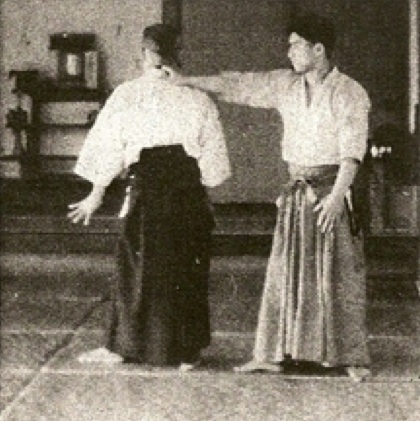 Gozo Shioda taking ukemi for Morihei Ueshiba in the 1938 manual “Budo”
Gozo Shioda taking ukemi for Morihei Ueshiba in the 1938 manual “Budo”
Kyoichi Inoue – Learning from the Kojiki
The Secret of “If it opposes then unify it”
(translated by Christopher Li)
The Founder told Shioda sensei – “Become a Kami”
I started four months after Gozo Shioda (塩田剛三) sensei established Aikido Yoshinkan (合気道養神館), on November 1st of Showa year 30 (1955). As one of the students in the first Kenshusei program that began the next year I literally walked the path of Aikido Shugyo together with the Yoshinkan. In Showa year 45 (1960) I was dispatched to the Metropolitan Police Department (警視庁), and until my retirement in Heisei year 8 (1996) I taught Aikido there. After Shioda sensei passed away I served as the second Kancho of the Yoshinkan. I would like to discuss why someone such as myself came to compile a book researching the Aikido based upon the teachings of the Founder Morihei Ueshiba and its relationship to the Kojiki.
It was on September 23rd of Showa year 36 (1961). Shioda sensei went to the Aiki Jinja in Iwama, in Ibaraki prefecture because he was to receive an examination for 9th dan from Morihei Ueshiba sensei. Even if we call it an examination, it was nothing like the examinations for regular students, who demonstrate techniques on each other and are then judged by the instructors. The first section was with bokken, and the next was empty hand, they were one-on-one sessions with the Founder. Shioda sensei was successfully awarded a 9th dan certificate by the Founder and returned to the Yoshinkan dojo (In Shioda sensei’s book “Aikido Shugyo” the date is given as Showa year 26 / 1951, but this appears to be an error in Sensei’s recollection at the time that the book was compiled. On the certificate itself the year is noted as Showa year 36.).
We heard from Shioda sensei that the Founder told him “Your Taijutsu (body art) has been developed enough. From now you must Shugyo (“train hard”) to become a Kami. For that reason you must take the spirit of something, anything, even an earthworm by the roadside. If you do that then you will be able to become a Kami”, but Shioda sensei laughed and said “Ueshiba sensei told me this, but I don’t want to become a Kami yet!”.
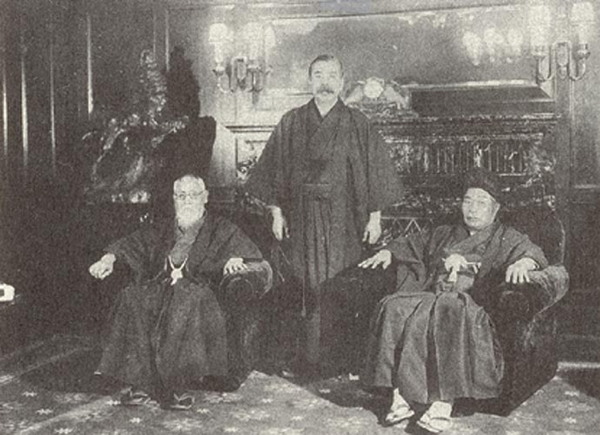 Onisaburo Deguchi (right) with Mitsuru Toyama (left) and Seiji Noma (middle), 1934
Onisaburo Deguchi (right) with Mitsuru Toyama (left) and Seiji Noma (middle), 1934
Mitsuru Toyama – radical right wing nationalist leader
Seiji Noma – founder of Kodansha publishing company, owner of the Noma Dojo
I won’t become a living Kami
I knew from listening to Shioda sensei that the Founder would often use that kind of terminology because he had learned Shinto from Onisaburo Deguchi (出口王仁三郎), the Founder of Omoto-kyo (大本教), when he was young.
I couldn’t even begin to understand why one could become a Kami by taking the spirit of an earthworm. We trained ourselves to become strong enough to lose to no one without having to depend upon any earthworms, and anyway, there was no way that anybody would be able to progress by taking the spirit of an earthworm. Honestly speaking, we had a hostile feeling towards the words of the Founder. We just forced ourselves to smile and said that his eccentric speeches were beyond our understanding.
Translator’s Note: Morihei Ueshiba’s teacher Onisaburo Deguchi saw the earthworm as a manifestation of the Dragon God (Ryujin/Owatatsumi). Accordingly, he saw the human spirit as subordinate to that of the earthworm. Further, Ueshiba stated at one point that this god (Ryujin) is the source of all Ki.
In the Yoshinkan at that time we had just begun the circuit training of the Metropolitan Police Department Riot Police, and we were burning with the conceit that our Aikido was solely a “jissen bujutsu” (“real fighting art” / 実戦武術). In part this may have been because I often accompanied Shioda sensei when he was invited to attend Aikikai demonstrations and I felt that Ueshiba sensei’s demonstrations were increasingly difficult to understand. Combined with a religious philosophy of the universe, I thought that they were becoming separated from the martial strength of their roots, and they seemed to be missing something to those of us swelling with the fire of youth. It seemed to us at the time that the Aikikai was worshipping the Founder as a living god (although that may not actually have been the case), there was a strong sense of rivalry and we latched on to Shioda sensei’s words “I don’t want to become a Kami yet!”.
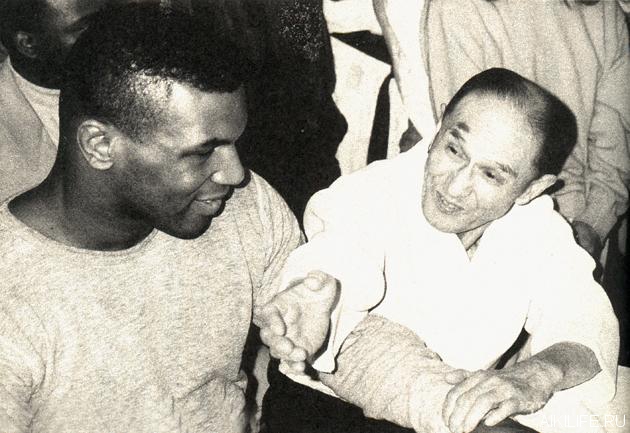 Mike Tyson visits the Yoshinkan and meets Gozo Shioda, 1990
Mike Tyson visits the Yoshinkan and meets Gozo Shioda, 1990
As for myself, I thought that it was extremely suspicious to treat anybody as a Kami, and whenever the subject was touched upon I would happily haul out Shioda sensei’s old stories of the Founder’s human failings. If one were truly a Kami then of course they would be a perfect saint beyond human understanding without the normal human flaws. For that reason, no matter how great and wonderful a Budoka Ueshiba sensei was, I believed that his numerous human failings made it impossible for him to be a Kami. I thought that for someone to call themselves a Kami was just some kind of pretension or conceit.
When Shioda sensei was young he studied and served under Ueshiba for a long time, but he was never religiously influenced. However, there was just one saying from Onisaburo sensei that he heard from the Founder and that resonated with him – “Our bodies are the temples of the Kami” (我が肉の宮に神宿る). Perhaps it was in that saying that he could measure the feelings of adoration that the Founder had for the Kami and the tales of the gods. That the gods were not something external to be relied upon, rather that he understood the Kami to be the great potential within oneself, the strength of one’s polished body and mind – that idea resonated with us greatly.
Because our Teacher was so, we the students completely ignored the Founder’s mythical explanations of Aikido as well. Wasn’t Shioda sensei’s Aikido the best, even without learning anything like that? We weren’t at all interested in training in Aikido to become living gods or to climb up to heaven.
“If it opposes then unify it” (対すれば相和す)
In his later years, Shioda sensei began to say “Aikido is to become one with the cycles of Heaven and Earth” (合氣道とは天地自然と一体になることだ), and “Ueshiba sensei would talk about gods and the universe, things that nobody could understand, but I have finally come to understand the meaning behind it”. When I was young Shioda sensei did only crushing, severe techniques that exhibited his Kokyu-ryoku, and when I took ukemi it was a constant struggle to survive. However, as the years passed by he mastered techniques for extinguishing and removing the power of the opponent and stood in a completely natural stance while destabilizing the opponent with complete freedom.
Before that time the techniques could not be resisted because of their strength, but that gradually changed into techniques that could not be resisted even though they were soft. Sensei would say that one takes possession of all of the opponent’s power. Perhaps it was when he mastered these high level techniques that he realized that Ueshiba sensei’s teaching “become one with the cycles of Heaven and Earth” was not as an abstract theory, but a reality.
Then, as I passed the age of sixty I myself was able to master those techniques that extinguished the power of the opponent. Now I call them “Nuki” (抜き), and as I mastered those techniques I became able to naturally give birth to them from a natural stance with complete freedom, without even the slightest need for any feeling of contesting with the opponent. I came to understand the true meaning of “Shizen-tai” (“Natural Stance” / 自然体). When that happened Aikido became more and more enjoyable.
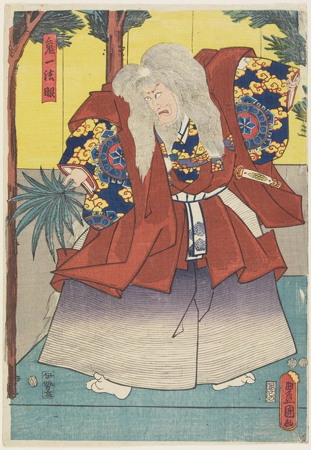 Woodblock print of Kiichi Hogen by Utagawa Kunisada
Woodblock print of Kiichi Hogen by Utagawa Kunisada
Shioda sensei always explained the swordsman Kiichi Hogen’s (鬼一法眼) saying “if it opposes then unify it” (対すれば相和す) to us as the secret of Aikido, and a representation of its mental principles, and I finally began to grasp the true meaning of what he was saying. (Translator’s Note: See the article “Kiichi Hogen and the Secret of Aikido” for a more detailed discussion.).
When performing “Nuki” techniques it isn’t just a matter of adjustments of power or technique, there is a sense of becoming one with your opponent’s spirit. When that occurs the opponent becomes unable to counter one’s movements. This becomes possible through a sense of one’s own spirit, and a sense of Ki. This really cannot be explained in words, one can only say that it feels like matching Ki (気を合わせる), just like the characters for “Aiki”. I have come to feel that one can begin to grasp the sense of this idea if one calls the state of Shizen-tai at that time “becoming one with the cycles of Heaven and Earth” (天地自然と一体になる).
Once I had grasped that Kokyu I became able to naturally keep Shizen-tai whenever I meet with other people. Until that time, as the Budo Shihan of the Metropolitan Police Department, knowing that Aikido must not be defeated by other Budo, I would go to work each day with the feeling that I was marching to a battlefield, but that fighting mood also disappeared.
Aikido is the Way of Putting the Kojiki Into Practice Through the Body
When I retired as the Kancho of the Yoshinkan in Heisei year 21 (2009) I established the Aikido Shinwakan (合氣道親和館). It was my hope to teach the traditional spirit of Japan to young people through the principle of “if it opposes then unify it” (対すれば相和す). The design of the Dojo’s insignia, as a symbol of the traditional Japanese spirit, incorporates a motif using the symbols of the imperial succession – the three sacred items of the imperial regalia, the mirror, the jewel and the sword.
At that time, Akio Jiromaru (治郎丸明穂), a student at the Yoshinkan who was researching into the mythology of the Kojiki, told me “Ueshiba sensei said that Aikido is the scroll of the Kojiki expressed in the body”. Since I had never heard of the Founder saying anything like that from Shioda sensei I was extremely surprised. At first I could not understand at all why the Kojiki, said to be Japan’s oldest historical record, would have any connection to Aikido. However, I knew that the source of the three sacred items of the imperial regalia contained in my own dojo’s symbol was recorded in the Kojiki. I couldn’t help but wonder about this mysterious connection.
When starting to examine the words of the Founder, I found that the works of the various gods that appear in the mythology most certainly express the Riai (理合 / the basic principles of the techniques) of Aikido.
The Founder did not perceive the works of the gods in the mythology of the Kojiki as being the deification of ancient rulers. Further, he did not perceive the words and actions of the gods appearing in human form in the Kojiki as occurring in a separate dimension.
The ancients, able to sense the great energy of nature, the universal energy behind all things, anthropomorphized the movements of that energy in order to transmit that knowledge to future generations. That this became the stories of the gods in the Kojiki is something that the Founder understood. For the Founder, the Kojiki was not simply a historical document, it was a secret record of the organization of the Ki energy sensed by the ancients, and the methods of its use.
Centered power (中心力), focused power (集中力), breath power (呼吸力), spiral movement (螺旋の動き), the connection of Ki (気のむすび), all of the unique principles of Aikido are led to from the stories of the gods. Without question, the works of the gods in the mythology of the Kojiki are present within the secrets of Aikido. We are putting them into practice through the body. At last, I have become able to understand the meaning of “Aikido is the realization of the Kojiki”.

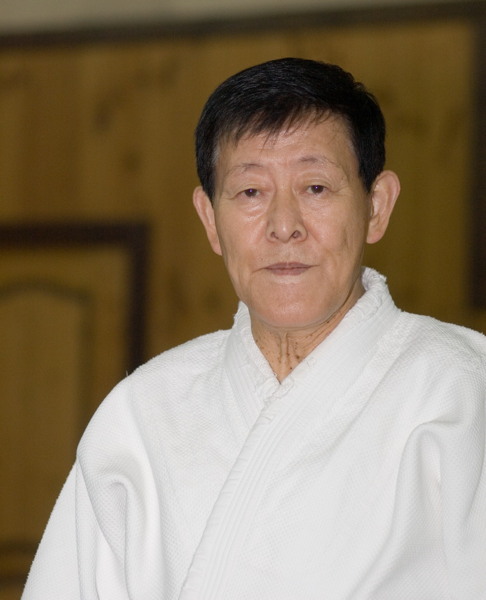
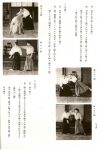
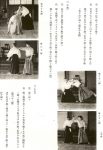

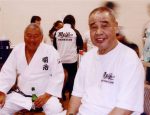
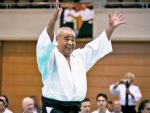

Congratulations Christopher on a very insightfull piece. Even if you translated Inoue sensei´s thoughts, which is difficult enough, publication of this helps me and hopefully many other people.
Thanks Frederic – Happpy New Year!
Best,
Chris
Another terrific, insightful and thought provoking endeavor. Thanks!
Thanks Gregg!
Best,
Chris
Caption for the Deguchi photo is wrong. Toyama Mitsuru is seated to the left; Noma Seiji is standing in the middle.
Thanks Steve! Fixed – only took two years for somebody to pick that up… 🙂
Best,
Chris
It’s a great photo. Tõyama, as mentor to Nakamura Tempū, plays a major role in my forthcoming book, “Heaven’s Wind.”
I’ve seen some of the “Heaven’s Wind” excerpts – looking forward to seeing the whole thing!
Best,
Chris
Gave a copy of “Heaven’s Wind” to Moriyama Sensei as a gift. He like it of course ☺
Great gift! Available from Amazon:
http://amzn.to/2D6CYQd
Best,
Chris
Hi Christopher,
I had the privilege of training with Inoue Sensei, he was a fine gentleman, sorry to hear of his passing.
Bob Noha
Don’t know about calling Kiichi Hogen a swordsman. Also, yes ki is a worm, ki.sei.shin three worms. A direct quote from the Founder seems to reference this but alas I cannot find it now. Seishin means spirit and shin means divinity. https://en.wikipedia.org/wiki/Three_Corpses
OK, so now we need an English version of the Kojiki. Thanks
It’s an interesting article, but the link to the Aikido Affinity Museum official website led to an advertising site that had nothing to do with the text.
I think it’s better to remove the link.
合氣道親和館
http://shinwakan.jp
Yes, I think that the site has gone inactive since his passing.
Best,
Chris